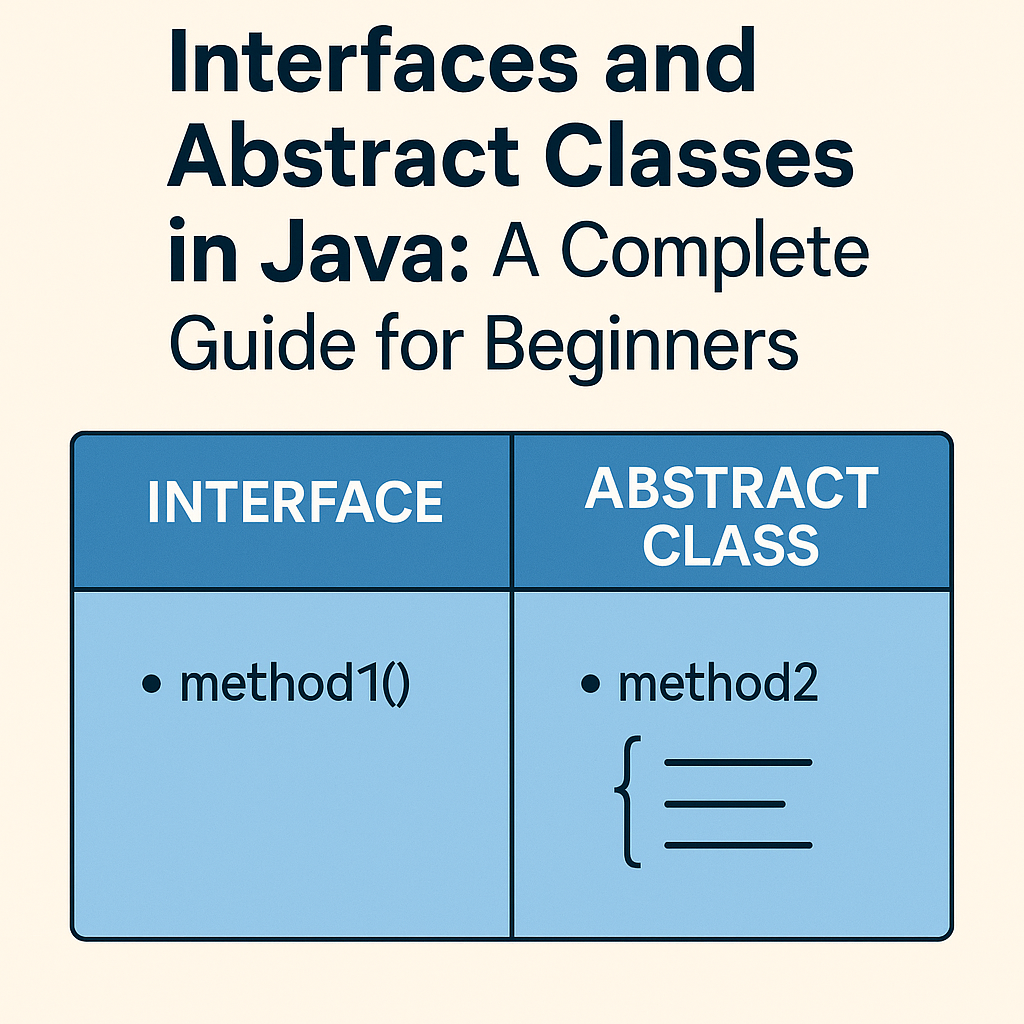Interfaces and Abstract Classes in Java
Java interface vs abstract class comparison chart for OOP design
Interfaces and Abstract Classes in Java: A Complete Guide for Beginners
Updated: July 25, 2025 | By Shubham mishra
When developing robust Java applications, understanding the key principles of abstraction is critical. Two of Java’s most powerful tools for achieving abstraction are Interfaces and Abstract Classes. Both allow developers to design flexible, maintainable, and scalable code — but they serve different purposes. In this tutorial, we will explore what interfaces and abstract classes are, when to use them, and how they differ.

What is Abstraction in Java?
Abstraction is a fundamental object-oriented programming concept. It allows you to define the structure or behavior of classes without revealing their internal implementation. Java supports abstraction using:
Abstract Classes
Interfaces
What is an Abstract Class in Java?
An abstract class in Java is a class that cannot be instantiated on its own. It is declared using the abstract keyword and may contain abstract methods (methods without a body) as well as concrete methods (with implementation).
Key Features:
Can have both abstract and non-abstract methods.
Can have constructors and member variables.
Supports access modifiers (public, protected, etc.).
Used when you want to share common code among closely related classes.
🧹 Example:
abstract class Animal {
String name;
Animal(String name) {
this.name = name;
}
abstract void makeSound(); // abstract method
void eat() {
System.out.println(name + " is eating.");
}
}
class Dog extends Animal {
Dog(String name) {
super(name);
}
void makeSound() {
System.out.println("Woof Woof");
}
}
What is an Interface in Java?
An interface is a completely abstract class used to define a set of methods a class must implement. It is declared using the interface keyword and does not contain any implementation (until Java 8+).
Key Features:
All methods are implicitly abstract and public.
Does not contain constructors or instance variables.
A class can implement multiple interfaces.
From Java 8 onwards, interfaces can have default and static methods with implementation.
Example:
interface Vehicle {
void start();
void stop();
}
class Car implements Vehicle {
public void start() {
System.out.println("Car is starting.");
}
public void stop() {
System.out.println("Car is stopping.");
}
}
Abstract Class vs Interface
| Feature | Abstract Class | Interface |
|---|---|---|
| Method Types | Abstract & Non-Abstract | Only Abstract (Java 7); Default/Static (Java 8+) |
| Variables | Instance variables allowed | Only constants (public static final) |
| Inheritance | Single inheritance | Multiple interface implementation |
| Constructors | Allowed | Not Allowed |
| Access Modifiers | Public, protected, private | Only public |
| Use Case | Shared code and hierarchy | Common behavior across unrelated classes |
When to Use What?
Use abstract classes when:
You need to define base behavior and enforce specific method implementation.
Classes are closely related and share code.
Use interfaces when:
You need to ensure multiple unrelated classes implement the same set of methods.
You want to simulate multiple inheritance.
Real-World Use Case
Consider a payment system:
Interface
PaymentGatewaymay defineprocessPayment(),refund(), etc.Different classes like
PayPal,Stripe, andRazorpayimplement it.
This approach promotes loose coupling and makes your application easy to scale and maintain.
Conclusion
Understanding interfaces and abstract classes in Java is essential for designing modular and reusable applications. Both tools support abstraction but serve different design purposes. Use abstract classes when you want to provide some common code. Use interfaces to define a contract across different classes.
Key Takeaways:
Use abstract classes for hierarchical class relationships.
Use interfaces for defining common capabilities.
Prefer interfaces for future-proof, extensible design in modern Java.
Table of content
- Introduction to Java
- Java Basics
- Object-Oriented Programming (OOP) in Java
- Exception Handling in Java
- Types of Exceptions
- Try-Catch Block
- Finally Block and Throw/Throws
- Custom Exceptions
- Java Collections Framework
- Introduction to Collections
- List, Set, and Map Interfaces
- ArrayList vs LinkedList
- HashMap vs HashSet
- File Handling in Java
- Multithreading in Java
- Introduction to Threads
- Thread Lifecycle
- Creating Threads (Thread Class vs Runnable Interface)
- Synchronization and Deadlocks
- Networking in Java
- Java Networking Basics
- Socket Programming
- HTTP Requests in Java
- Java Database Connectivity (JDBC)
- Introduction to JDBC
- Connecting to MySQL Database
- Executing SQL Queries
- Using Prepared Statements
- Java Frameworks and Technologies
- Introduction to Spring Framework
- Hibernate ORM
- JavaFX for GUI Applications
- Java Interview Preparation
- Additional Java Resources
- Best Books to Learn Java
- Java Certification Guide
- Online Java Practice Platforms